See also:
Mikado Hotel, Miyajima, c. 1910
“The apparition thanked [Taira no] Kiyomori for the repair of ‘our pagoda’ and urged him to attend next to ‘our shrine’ of Itsukushima in Japan’s Inland Sea. The Itsukushima Shrine, the apparition explained, was another place where the Great Sun Buddha manifested himself. If you rebuild the ruined shrine you ‘shall rise to high office. None will be able to keep abreast of you in your rise to glory.’ With this promise the apparition vanished, leaving behind only the fragrance of incense.
“In response Kiyomori rebuilt the magnificent (and now world-famous) ‘floating’ Itsukushima Shrine on the island Miyajima … From the moment of the Itsukushima oracle Kiyomori enjoyed one triumph after another. He made Itsukushima his family shrine and prayed there Benzaiten, asking that his daughter conceive a son whom he could declare emperor. This quickly came to pass. So godlike in power did Kiyomori become that some said he was the incarnation of the Buddha.”
– Sacred Koyasan: A Pilgrimage to the Mountain Temple of Saint Kobo Daishi and the Great Sun Buddha, Philip L. Nicoloff, 2008
“It may be thought that such great reverence for the Ise Shrines by the shrines Japanese and their worship of them amount to idolatry for it is only a mirror which is at the centre.
“Idolatry is accompanied, however, by the desire to get something substantial from an idol, believed to possess miraculous power. The reverence of the mirror by the Japanese has a different meaning.
“Some ignorant people may so idolize but the bulk of the nation worships the spirit of the Goddess Amaterasu through the Sacred Mirror, in tribute to the founding of this country by her, believing that her divinity still lives, protecting her Imperial posterity and her nation.
“They pray for her great mercy, and and not for any favour from the mirror itself. There is no difference from motive for worshipping at the Holy Mother’s portrait or images in Roman Catholicism, or carrying the cross in a similar Protestant rites.
“Shintoism originates in the belief that the divine spirits of Amaterasu and the other Gods and Goddesses protect the nation. This belief was produced because of Japan having been a united nation for the past two thousand years. It is ancestor worship, and such worship, kept up for two thousand years, cannot be experienced by any other nation but Japan, which has never been invaded by other peoples. Here is the pride of the Japanese nation.”
– “The Grand Shrines of Ise”, The Japan Magazine, June 1923
“Itsukushima Shrine is a Shinto shrine on the island of Itsukushima (popularly known as Miyajima), best known for its ‘floating’ torii gate. The shrine has been destroyed many times, but the first shrine buildings were probably erected in the 6th century. The present shrine dates from the mid-16th century, and is believed to follow an earlier design from the 12th century. That design was established in 1168, when funds were provided by the warlord Taira no Kiyomori. The shrine was designed and built on pier-like structures over the bay so that it would appear to be floating on the water, separate from the sacred island, which could be approached at low-tide by the devout.
“The dramatic gate, or torii, of Itsukushima Shrine is one of Japan’s most popular tourist attractions, and the most recognizable and celebrated feature of the Itsukushima shrine, and the view of the gate in front of the island’s Mount Misen is classified as one of the ‘Three Views of Japan’ (along with the sand bar Amanohashidate, and Matsushima Bay). Although a gate has been in place since 1168, the current gate dates back only to 1875.
“The torii appears to be floating only at high tide. When the tide is low, it is approachable by foot from the island. Gathering shellfish near the gate is also popular at low tide. Many locals add the shellfish they gather to their miso soup.
“Retaining the purity of the shrine is so important that since 1878, no deaths or births have been permitted near it. To this day, pregnant women are supposed to retreat to the mainland as the day of delivery approaches, as are the terminally ill or the very elderly whose passing has become imminent. Burials on the island are forbidden.”
– Wikipedia


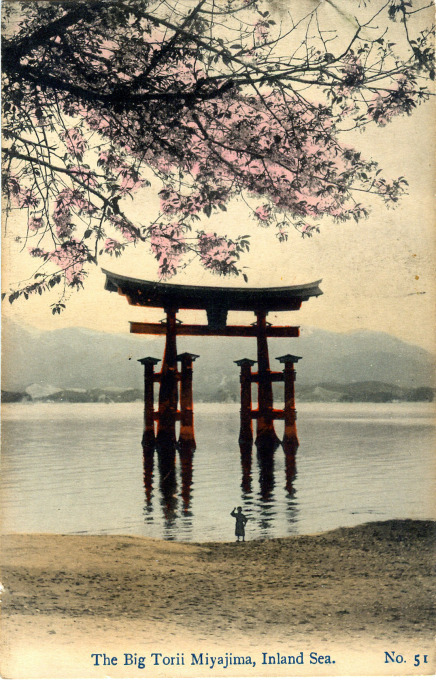
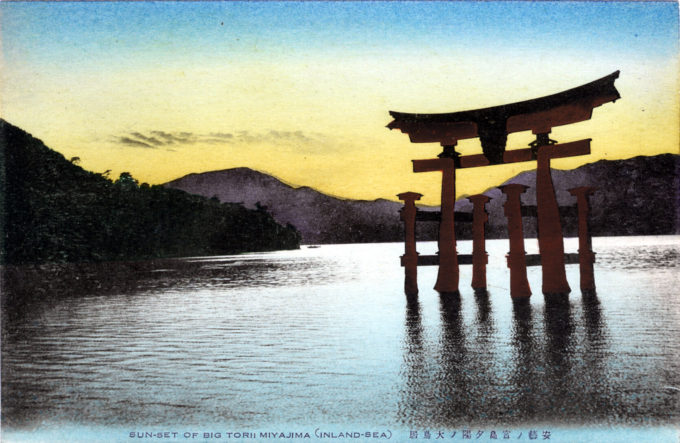
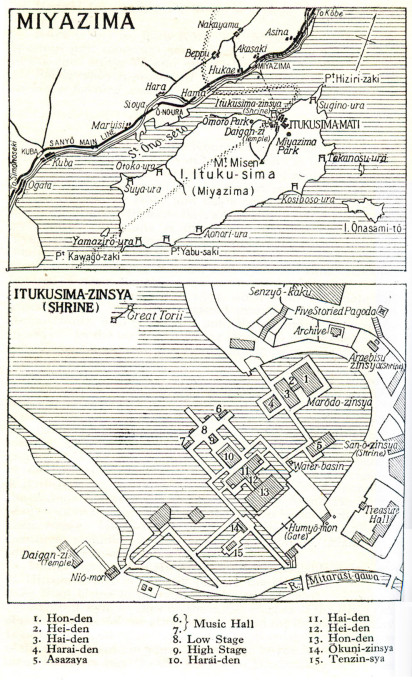
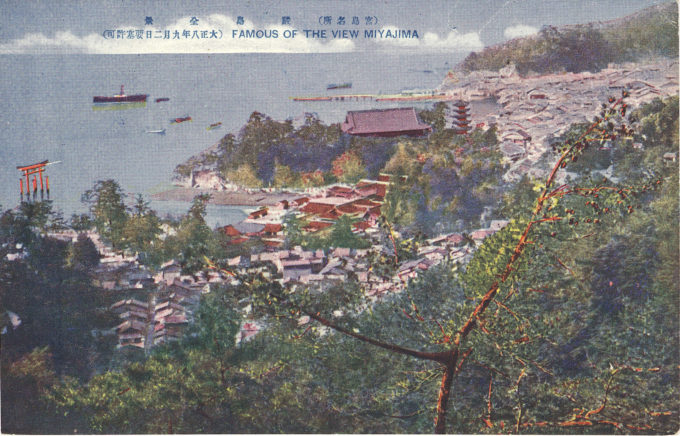
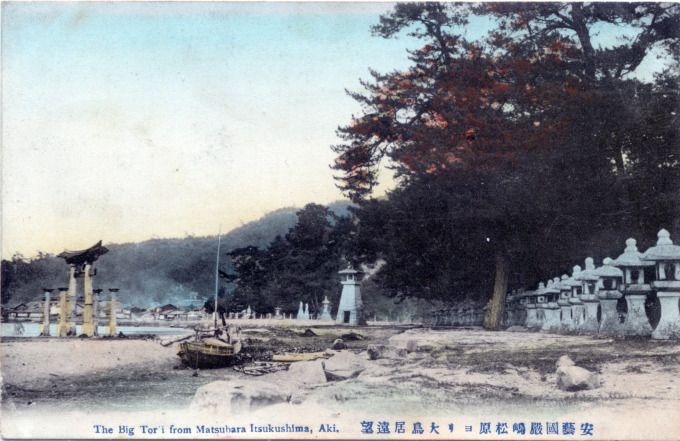
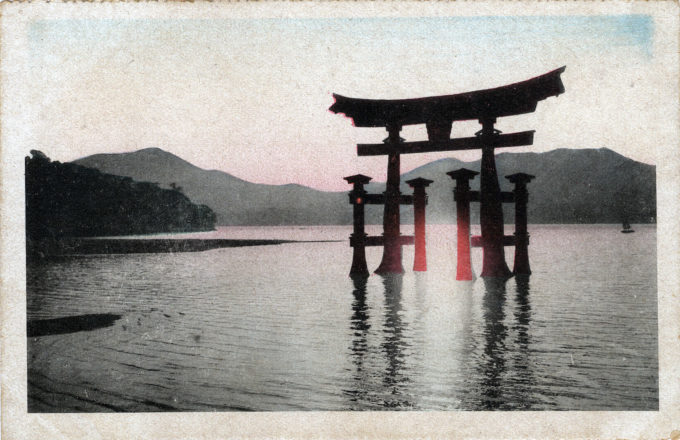
Pingback: View of Matsushima, Inland Sea, c. 1910. | Old Tokyo
Pingback: Miyajima (Mikado) Hotel, Miyajima, c. 1910. | Old Tokyo
Pingback: Matsushima Park Hotel, Matsushima, c. 1920. | Old Tokyo
Pingback: Kotohira-gu, Toranomon, Tokyo, c. 1910. | Old Tokyo
Pingback: Torii and toro, "Starlit Night, Miyajima", shin-hanga by Hasui Kawase, 1928. | Old Tokyo
Pingback: M.S. “Oto-maru”, Inland Sea routes, O.S.K. Lines, c. 1930. | Old TokyoOld Tokyo